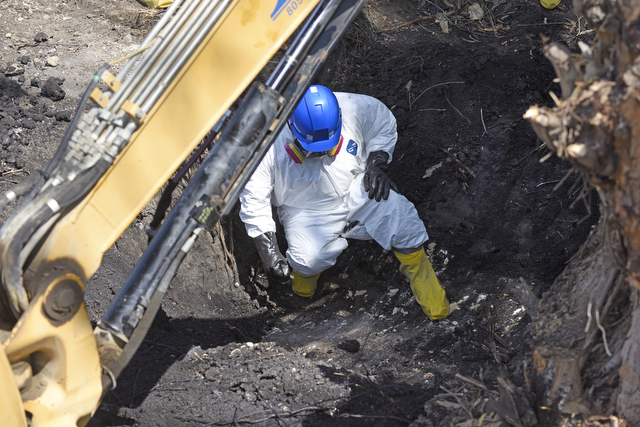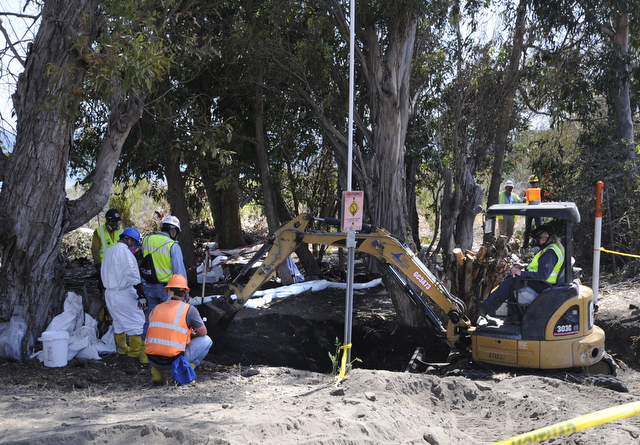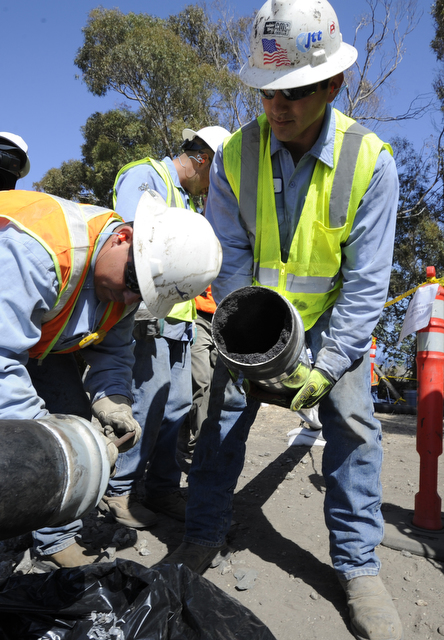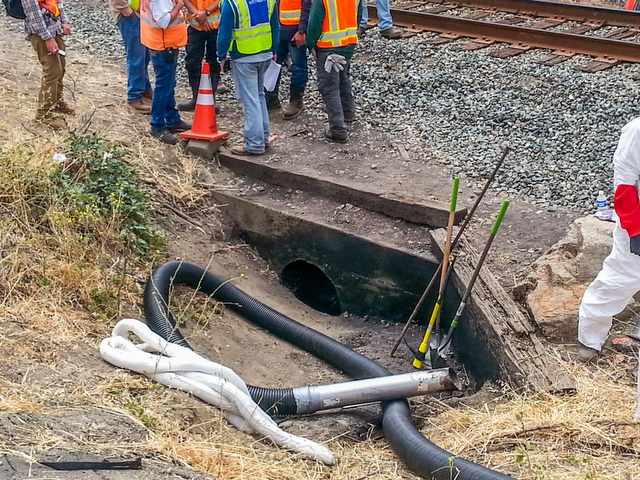Refugio Oil Spill: The 80,000-Gallon Question
As Ocean Cleanup Winds Down, Land Crews at Ground Zero Continue to Dig

One of the stickier questions lingering a month after the 100,000-gallon Refugio Oil Spill is, what happened to the 80,000 gallons that didn’t make it into the ocean?
Some of the oil was quickly scooped off the ground near the ruptured pipeline or soon after scrubbed from the drainage culvert that funneled it toward the shore. But that accounts for just a fraction of the crude that spilled on land.
Once it exited the cement-lined culvert below Highway 101 and adjacent railroad tracks, the oil flowed freely for 200 yards along three-story coastal bluffs dotted with eucalyptus trees; 20,000 gallons dropped to the beach and water below.
As the crude crept along, leaving a shiny black swath in its wake, it seeped into the bluffs’ porous soil and spread down and out between underground rocks and roots. If you were to take a cross section of the affected area, it would look like a pyramid, said Steve Calanog with the EPA during a recent site visit.

Cleanup crews wearing ventilation masks and full-body suits have been excavating the seaside bluff for the last few weeks. The work will continue for another two to three months, he said.
Calanog admitted officials were unsure how deep the oil went. And they don’t know if it could still slowly leak into the ocean. “That’s one of the million-dollar questions,” he said.
Last Thursday, cleaning teams used a backhoe to scoop large quantities of blackened earth into awaiting bins. A Chumash representative scrutinized every load for any culturally significant items. If none were found, the dirt was sucked through a large vacuum into a dumpster.
Milling about was a small army of Coast Guard, EPA, and California State Parks personnel. Some held monitors that could detect trace amounts of benzene and other carcinogens found in produced oil. Low levels of benzene had already been identified, Calanog said.
“Crude is a soup of a lot of different chemicals,” he explained. “It’s full of volatile organic compounds and metals.” Calanog also said the crude that came from the Plains All American pipeline is very different chemically from the oil that naturally seeps out of the sea floor.

As dumpster after dumpster was filled with polluted dirt, they were trucked a short distance away to a staging area right next to the spill site. The containers were then tallied to determine how much errant oil has been collected so far, and the soil was tested and classified batch by batch to determine how toxic it was. If it wasn’t too contaminated, it was shipped off to cover roads and landfills. If it was really noxious, it was tagged to be put in landfills.
As it turns out, the Plains pipeline broke along an especially unlucky stretch of its 10-mile span. The rupture was situated almost directly above the culvert’s mouth and had a straight shot to its opening. If the spill had occurred just a few hundred feet in either direction, the fallout would have been much less severe, Calanog said.
State Park Superintendent Eric Hjelstrom was also at the excavation site. He said it’s anyone’s guess how far down the oil goes. The latest phase of the land-based cleanup is the most intensive and poses the most complications. But, Hjelstrom explained the teams won’t stop until the oil is all gone. “It’ll be a big hole,” he said. Crews have so far removed nearly 6,000 cubic yards of oiled soil.
El Capitan State Beach will reopen June 26, officials announced yesterday. Refugio State Beach remains closed, and reservations there have been cancelled through July 9. More reservations may be cancelled depending on the pace of the ongoing cleanup, though more than 10,580 feet of boom along the beach’s high-tide line was recently removed.

Of the 96.5 miles of shoreline surveyed in Santa Barbara and Ventura counties, 91 percent have “met cleanup goals,” according to a June 14 press statement. “Clean areas will continue to be monitored for re-oiling which may occur, especially with the natural oil seeps in the area,” it reads. “Teams will also continue to take samples.”
The Independent has submitted a formal request to the Santa Barbara County Public Health Department for the results of water and soil tests conducted during the last four weeks. That request is still being processed, officials said.
No visible oil has been found on the surface of the ocean since June 3, so booming and skimming operations have been reduced to a single boat, Coast Guard and EPA representatives said. As many as 18 vessels were on the water at one point. The number of field workers peaked at around 1,400 shortly after the May 19 spill, and around 750 remain, with 100 more personnel in Unified Command headquarters.



